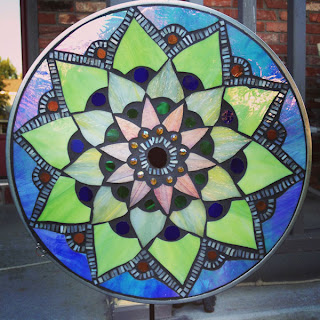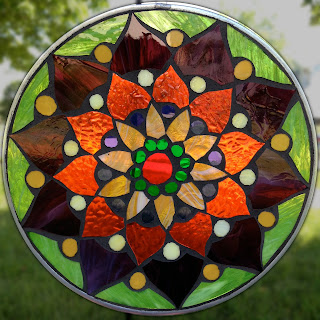As a Girl Scout Community Collaborator, I work with Girl Scout troops to create glass art. Sometimes we meet for glass fusing, but this post is about mosaic stepping stones...
 |
| I prep the paver stones, so we're ready to get started when you get here. |
There are a few different approaches to making mosaic stepping stones
and as an introduction to the process I choose the easiest and most
accessible way! Instead of having to build upside down, pouring cement
and having to wait to get your stepping stone back, we use paver stones
from the hardware store. I gather all the materials and get them prepped
before you show up. I choose the 6" x 8" paver stones, because that
guarantees that we finish close to the 3 hour mark. After I clean the
stones, I prep them with the adhesive. (It's a
heat set adhesive that cures quickly to allow us to finish the class by grouting, instead of waiting for glue to dry.)
 |
| Piecing the glass together on the paver stones |
Then, when you show up, we talk about how to safely "play" with glass, how to cut it with nippers and rules for arranging a mosaic and using the groutlines for design. If the weather permits, we work outside the whole time. Otherwise, we'll work in my studio. (For large groups, we meet at
Architectural Glassarts.) I encourage everyone to come to class with an idea of what they might like to make: flowers, cars, animals, sun, moon, ocean, mountains, pineapple, etc. It doesn't mean you won't get inspired by the glass to make something else, but it helps get past the "creative block."
 |
| Grouting the stepping stones |
After covering the paver stone with glass, it's time to pop them in the oven to cure. Then, we take a studio tour, and I talk more about glass and different things you can do with it. If you'd prefer to make this snack time, we can definitely do that, too! We have about 30 minutes to wait while the stones heat up and then cool back down and are ready to grout. Then it's time to get dirty! You may want to wear clothes that can get stained...
 |
| Stepping stones finished in 3 hours |
We grout in the grass because it's super easy to clean up that way. I show you how to mix the grout and help you to get the right consistency. Then, we spread the grout across our pieces. It needs to sit for 5-10 minutes before we can polish it off and make the glass shine and sparkle, but then we're finished and the stones are ready to take home with the girls!
 |
| Beautiful flower stepping stone |
If this is something you'd like to do with your Girl Scout troop, please
contact me for a list of available dates. Current pricing is $25 a girl, which is a steal!





































